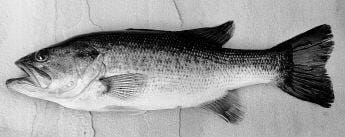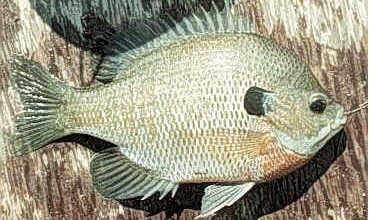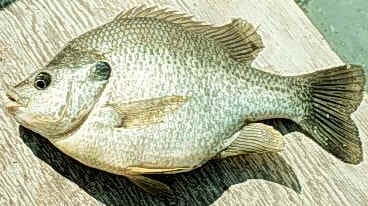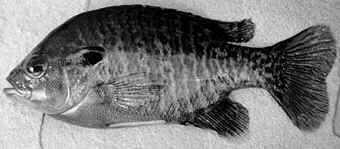 |
||||
Chapter 2: Stocking and Harvesting
Prestocking Procedures
New Ponds: Plan construction so the pond is completed and filled by September or early October. Ponds filled in the summer may become contaminated with undesirable fish, which should be removed before stocking.
Existing Ponds: Restocking a pond usually requires eradicating existing fish populations (a process known as pond reclamation). Contact your Cooperative Extension Center or the North Carolina Wildlife Resources Commission to determine if reclamation is necessary; sometimes the problem may be solved by other means. Pond reclamation may be required if undesirable species, such as crappies or bullheads, are found in the pond, and occasionally is necessary when fish populations become too unbalanced (for example, when there are too many sunfish and no bass). Undesirable fish populations are eliminated by using a fish toxicant called rotenone. Rotenone may be purchased from the Wildlife Resources Commission, and must be applied by a licensed pesticide applicator. Follow these steps when reclaiming a pond with rotenone:
Plan the reclamation for August or September. The water is warm at this time, and rotenone will detoxify quickly. This will also allow time for the pond to refill by fall when sunfish are normally restocked.
Prepare the pond by lowering the water to its lowest level. This reduces the amount of rotenone needed and concentrates the fish in a smaller area, ensuring a complete kill. Close the overflow pipe and check daily for leaks so that treated water will not escape and kill fish downstream.
Contact the Wildlife Resources Commission to obtain rotenone. After treatment, most fish will die and come to the surface within 24 hours, although fish may continue to appear for several days. Rotenone is not approved by the Food and Drug Administration for human consumption, and therefore the poisoned fish should not be eaten by humans or livestock. Bury them to prevent odors and pest problems.
Allow at least 10 days for the rotenone to break down (detoxify) naturally. In warm water (65o to 70oF) the rotenone should be gone in approximately four days. The treated water should not be used for watering livestock for at least 10 days and should not be released from the pond for at least two weeks after application. Fish may be stocked two weeks after treatment.
Selecting the Proper Fish
Largemouth bass, bluegills, redear sunfish, hybrid sunfish, and channel catfish are the only fish with which a warmwater pond should be stocked. Research has proven that various combinations of these fish produce the best pond fisheries. Stocking the pond with any other species of fish makes it difficult to manage, usually resulting in poor fishing and an unbalanced fish community. The following paragraphs briefly describe the desirable fish species and their characteristics to help you better understand fish populations.
Largemouth Bass. This species is recognized by its large mouth and dark stripes or blotches down its side (Figure 3). Young bass feed on microscopic animals (zooplankton) and insects until they are 2 inches long, when they start feeding on fish. Adult bass eat mostly fish, but they also eat large insects, frogs, and crayfish when available. Although their growth rate varies across North Carolina, most bass reach a harvestable size (12 inches) in 2 to 3 years when food is abundant. Bass spawn once a year, usually beginning in late March in eastern counties and as late as June in western counties.

Bluegill. This species of fish, also called bream (or brim), is recognized by its small head and mouth and an irregular black spot located at the base of the soft dorsal (top) fin (Figure 4). Broad, dark vertical bands can sometimes be seen on the sides of the fish when it is in the water. Bluegills prefer to eat insects but they also sometimes feed on small fish. Their growth rate depends on the amount of food available and the number of fish in the pond. It usually takes three years to produce fish of harvestable size (5 inches long). Bluegills spawn frequently from May through October when the water temperature is 67-80F. Because they produce such large numbers of young fish, they are the primary food source for largemouth bass.

Redear Sunfish. Also known as the shellcracker, the redear sunfish has a small mouth and head and is shaped much like a bluegill (Figure 5). The opercular (cheek) tab of the redear is black with a red-orange border, and breeding males have a bright orange border. The redear is primarily a bottom feeder, eating mostly snails and insects. Its growth rate is similar to that of the bluegill, but redears typically reach a larger size because they are harder to catch. They are less prolific than bluegills and rarely become overpopulated.

Hybrid Sunfish. This fish is a cross of two different sunfish species, usually a bluegill and a green sunfish (Figure 6). The hybrid sunfish resembles the bluegill but has a much larger mouth. It is an active feeder and is generally easier to catch than other sunfish. Because of their voracious feeding activities, hybrid sunfish can reach a harvestable size (5 inches) in about two years. Hybrid sunfish spawning is limited because approximately 90 percent are males.

Channel Catfish. This type of catfish can be recognized by its scaleless body, chin barbels (whiskers), dark spots scattered on the body, forked tail, and barbed spines on the dorsal and pectoral (side) fins (Figure 7). Channel catfish will eat almost anything, but they prefer insects, small fish, and crayfish. They readily adapt to an artificial (pelleted) diet, which increases their growth rate. They are capable of spawning in ponds, but because of egg predation by bluegills and fingerling predation by bass, very few young channel catfish survive. Spawning success may be improved by placing 2-foot sections of terra-cotta pipe (8 to 12 inches in diameter) perpendicular to the bank in 2 to 4 feet of water.

The above species are the only ones recommended for warmwater pond stocking. Crappies, bullheads, and other sunfish species should not be stocked because they tend to become overcrowded, resulting in populations that can be corrected only by pond reclamation.
Stocking Options
Except for supplementary stocking of hybrid sunfish or channel catfish, stocking a pond that already contains fish is normally not recommended. Before stocking a new or reclaimed pond, contact the Cooperative Extension Service or the Wildlife Resources Commission for assistance in selecting a stocking regime best suited to your management plan for the pond. Stocking the pond with the proper species and numbers of fish at the proper time, combined with good management practices, is necessary to maintain good fishing.
Sunfish fingerlings should be stocked in the fall, usually in October or November, so they can grow large enough to avoid predation by bass, which are stocked the following June. The fish stocking combinations given in the accompanying tables usually produce a successful fishery. The stocking rates, which depend on whether or not the pond will be fertilized, are given as a general guide. In some cases the stocking rate should be altered, depending upon the pond management plan, extent of fishing, water quality, and other uses of the pond.
| Option 1: Largemouth Bass and Sunfish Fingerlings in a 1-to-10 Ratio | ||||
| Number Per Acre | Size | |||
| Species | Fertilized | Unfertilized | (inches) | When Stocked |
|---|---|---|---|---|
| Bluegill | 700 | 350 | 1 to 2 | Oct. to Nov. |
| Redear sunfish | 300 | 150 | 1 to 2 | Oct. to Nov. |
| Channel catfish (optional) |
100 | 50 | 2 to 4 | Oct. to Nov. |
| Largemouth bass | 100 | 50 | 2 to 4 | The following June (after sunfish) |
Option 1 is an economical and commonly recommended stocking plan for establishing a fishery of largemouth bass and bluegills. However, harvesting must usually be postponed at least two years for sunfish and three years for bass. Supplementary stockings of channel catfish may be necessary after several years; if so, 6- to 8-inch fingerlings should be stocked to reduce predation by bass. These rates should be used for ponds of 10 acres or less. Ponds larger than 10 acres should be stocked with 3,500 bluegill, 1,500 redear, 500 largemouth bass, and 500 channel catfish.
| Option 2: Largemouth Bass and Sunfish Adults | ||||
| Number | Size | |||
|---|---|---|---|---|
| Species | Per Acre | (inches) | When Stocked | |
| Bluegill | 70 | 3 to 5 | April | |
| Redear sunfish | 30 | 3 to 5 | April | |
| Largemouth bass | 20 | 8 to 14 | April | |
Stocking adult fish (option 2) usually costs more than stocking fingerlings, but it will provide fishing sooner. Ponds larger than 10 acres should be stocked with 700 bluegill, 300 redear sunfish, and 200 largemouth bass.
| Option 3: Channel Catfish and Hybrid Sunfish Fingerlings | ||||
| Number | Size | |||
|---|---|---|---|---|
| Species | Per Acre | (inches) | When Stocked | |
| Channel catfish | 100 | 2 to 4 | June or July | |
| Hybrid sunfish | 300 | 1 to 2 | June or July | |
Option 3 yields an excellent fishery for avid catfish and sunfish fishermen and is the best option for ponds of less than 1 acre. These fish grow quickly when fed a commercial fish diet. Since their reproductive potential is limited, both species should be restocked every two years at the original stocking rate.
A list of commercial hatcheries that sell fish for stocking private ponds may be obtained from your Cooperative Extension Center, the North Carolina Department of Agriculture (NCDA) Division of Aquaculture and Natural Resources (919-733-7125), or on the World Wide Web at: http://www.ces.ncsu.edu/nreos/wild/aquaculture/. It is advisable to contact several commercial facilities to obtain the best price and delivery arrangements. Also ask about guarantees or replacement policies in case your fish die shortly after stocking.
Mountain Trout Ponds
Most North Carolina ponds are best suited for the warmwater species described above. However, some ponds above 3,000 feet in elevation in Western North Carolina are sufficiently cold year-round to support rainbow trout. Before stocking trout in your pond, it is critical to determine that conditions will be appropriate year-round. Water temperatures that exceed 70EF for more than a few hours can be lethal to rainbow trout. Many ponds in western North Carolina exceed 70EF during the summer due to inadequate water flow.
Due to natural food limitations, trout in ponds usually must be fed a high-protein, pelleted trout feed (preferably floating). Suitable stocking rates vary depending on water flow, pond size, and management preferences, but typically range from about 300 5- to 7-inch fingerlings per acre if not fed, to 500 per acre if fed. Trout will not successfully reproduce in ponds, so periodic supplemental stocking will be necessary. No other species of fish should be stocked with trout. Trout ponds should not be fertilized, as trout are especially sensitive to low nighttime dissolved oxygen concentrations that sometimes occur in fertile ponds.
More detailed information on pond requirements, trout fingerling suppliers, stocking rates, and feeding rates for trout ponds is available from your county Cooperative Extension Center or on the World Wide Web:
http://haywood.ces.state.nc.us/pubs/trout/pond.html
Harvesting
Proper fish harvesting is one of the more important factors in pond management. You may fish the pond after the first year, although bass should not be harvested until after the third year or when they reach 12 to 14 inches in length. Overharvesting, particularly of bass, may easily occur when a pond is first opened to fishing, and it can ruin a good pond. The bass originally stocked must support the bass harvest for at least three to four years from the time of stocking.
Bass growth and subsequent harvesting rates are different for each pond. As a general rule, unfertilized ponds receiving runoff from agricultural lands can support a harvest of about 20 to 25 pounds of bass per acre each year. In excavated or infertile ponds, about 10 to 15 pounds per acre is a safe rate. These harvesting rates may be doubled if the management plan includes a fertilization program.
A 12- or 14-inch size limit for bass should be established. Unless they become overcrowded, bass under 12 inches should not be harvested because they are very aggressive feeders and help maintain the proper population balance between bass and sunfish. All fish to be released should be handled carefully and returned to the water as quickly as possible. However, remember that harvesting some bass is important for maintaining the quality of the fishery; practicing strict catch-and-release bass fishing may lead to an overcrowded population and stunted bass.
Remember to spread the harvest throughout the fishing season. If too many adult bass are removed, particularly in the spring, the bluegills may become overcrowded. Keep a record and request others fishing the pond to record the number of bass caught and the number removed from the pond. When the annual quota is reached, fishing may continue but any bass caught should be released.
Good records should also be kept for the other fish caught, particularly channel catfish and hybrid sunfish. As a rule, these two species may be harvested at will. However, if large numbers are removed soon after fishing begins, restocking may become necessary earlier than anticipated.
Sunfish growth and harvesting rates are also different for each pond. As a general rule, you may remove at least 40 pounds of harvestable-size sunfish per acre annually from an unfertilized pond. This rate may be doubled for ponds with high basic fertility and those in which a fertilization program is used. Always harvest more sunfish, particularly bluegills, than bass. Attempt to harvest approximately 4 to 5 pounds of sunfish for each pound of bass per year. Sunfish are rarely overharvested, but underharvesting of sunfish is one of the most common causes of pond problems. When in doubt, it is better to keep a sunfish than throw it back.
Determining Balance
When is a fish population in balance? How can I determine if a balanced condition exists in my pond? These are two questions often asked by pond owners. Actually, a truly balanced condition never exists in a pond. Fish populations continually change and never reach the state of equilibrium, or general stability, referred to as balance. Fisheries biologists sometimes use the term to describe satisfactory relationships between the predator (bass) and prey (bluegill) populations of a pond. Generally, a balanced population must provide three things:
- Fish of harvestable size
- Annual reproduction
- A combination of fishes, including at least one predator species.
Unbalanced populations are those unable to produce annual crops of harvestable-size fish.
The two methods described in the accompanying table may be used to determine balance in a pond of largemouth bass and bluegills. The first method, using angler harvest information, is based on a correctly stocked bass-bluegill combination. The seine method, using a minnow seine 20 feet by 4 feet with 1/4-inch mesh, is effective during June and July in ponds containing a bass-bluegill population at least two years old. Sampling four or five shoreline locations around the pond should yield results in one of the population condition categories.
If the results from one or both of these methods indicate an overcrowded or undesirable condition, contact your county Cooperative Extension Center or the Wildlife Resources Commission for assistance. The Extension agent or fisheries biologist will usually recommend a corrective measure described for the following population conditions.
Overcrowded Bass. If bass populations are overcrowded, the situation can usually be corrected by harvesting the surplus bass. Harvest up to 30-50 bass per acre if the population is severely overcrowded.
Overcrowded Bluegills. This condition can sometimes be corrected by removing at least 100 pounds of sunfish per surface acre of pond. If few bass are present, restock the pond with 50 advanced (6- to 8-inch) bass fingerlings per acre. If overcrowding is not too severe, winter drawdown may correct the problem. Reducing water levels from December 1 to March 1 to approximately one-half the normal pond level concentrates the stunted sunfish, allowing bass to consume the surplus fish. If overcrowding persists, the pond should be drained, poisoned with rotenone (reclaimed), and restocked with the correct bass-to-bluegill ratio.
Undesirable Fish Population. Fish removal or drawdowns are rarely effective in eliminating populations of undesirable fish species. This problem usually requires pond reclamation and restocking to establish a successful bass-bluegill fishery.
Methods for Determining Pond Balance
| I. Angler Method | ||||
| Harvest Data | Population Condition | |||
|---|---|---|---|---|
| Bluegills 6 inches and larger. Bass average from 1 to 2 pounds, although smaller and larger sizes also caught. | Balanced population. | |||
| Bluegills average more than 1/3 pound. Bass average less than 1 pound and are in poor condition. | Unbalanced populations with bass overcrowded. (May be desirable if large sunfish are preferred.) | |||
| Principally small bluegills, 3 to 5 inches long. Very few bass are caught, and those caught are larger than 2 pounds in size. | Unbalanced populations with bluegills overcrowded and stunted (May be desirable if trophy bass are the primary objective.) | |||
| Small crappies, sunfish, bullheads, carp, suckers, or other undesirable fish of any size. | Undesirable fish population. | |||
| II. Seine Method | ||||
| Fish Collected by Seining | Population Condition | |||
|---|---|---|---|---|
| No young bass present. Many recently hatched bluegills. No or few 3- to 5-inch bluegills. | Unbalanced populations with bass overcrowded. | |||
| No young bass present. No recently hatched bluegills. Many 3- to 5-inch bluegills. | Unbalanced population with bluegills overcrowded. | |||
| Young bass present. Many recently hatched bluegills. Few 3- to 5-inch bluegills. | Balanced population. | |||
| Young bass present. No recent hatch of bluegills. No 3- to 5-inch bluegills. | Unbalanced population. Bluegills absent. | |||
| No game fish species present. Few to many carp, suckers, bullheads, shad, or other undesirable species. | Undesirable fish population. | |||

